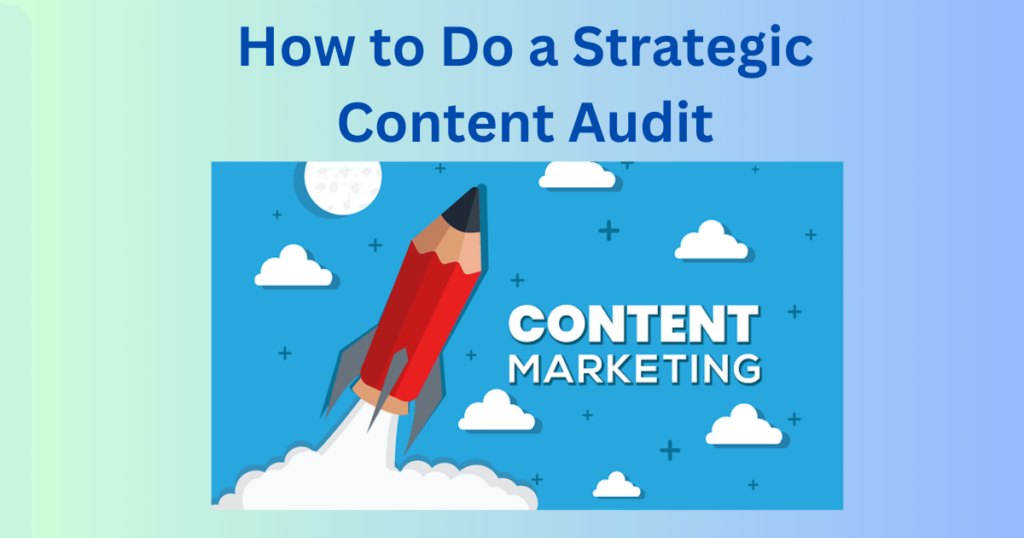If you are looking to influence revenue from your content marketing, then this blog will be helpful for you.
Traditional content audits focus on SEO metrics, traffic, and technical issues. A good guide for this type of audit is here by ahrefs and another good one by SEMRush.
For enterprise B2B clients where the sales is complex and transactions are very high ticket with long term engagements, I generally add in a strategic buyer journey-centric approach to the traditional style content audit.
My method prioritizes customer needs and revenue enablement, ensuring that your content effectively guides prospects through their decision-making process.
Let\’s briefly explore this two-layer framework for conducting a strategic content audit.
Two Levels of Content Audit
A comprehensive content audit should be conducted on two levels to maximize its effectiveness:
Level 1: Buyer Journey-Centric Content Audit
This level focuses on ensuring that your content aligns with the stages of the buyer journey. It evaluates five key dimensions:
- Buyer journey stages & conversion enablement at the top level, and then
- Your differentiation (this often gets forgotten in the noise)
- Key GTM partner inclusion
- Solutions positioning, and
- Technical/industry domain expertise
This helps in creating a customer-centric content strategy that addresses the needs of potential buyers at every stage of their journey.
Our focus here to be helpful to clients and facilitate strong sales enablement suitable for all buyer journey stages.
Level 2: Traditional SEO and Performance Metrics Audit
The second level of content audit involves evaluating your content\’s performance based on traditional SEO metrics and technical factors.
This includes analyzing keyword optimization, keyword coverage, content media types, backlinks, top-performing content, and technical aspects.
This layer ensures that your content is optimized for search engines and user engagement too.
By conducting content audits at both levels, you can create a holistic content strategy that not only attracts traffic but also drives engagement and conversions.
With this introduction out of the way, let\’s now uncover Layer 1 in more detail.
Layer 1: Buyer Journey-Centric Content Audit
The first layer of our framework focuses on assessing your content\’s alignment with the buyer journey.
You evaluate five key dimensions: buyer journey stages, differentiation, partner inclusion, solution positioning, and domain expertise.
1. Addressing the Buyer Journey Stages
Note: First start by mapping the stages of the buyer journey: awareness, consideration, and decision. Create your customer personas if you don\’t have them (multiple if needed), and define what you bring that is uniquely value adding to the customer. This is not about you, but how it benefits or relates to the personas.
- Audit Steps:
- Inventory Content: Create a comprehensive list of all existing content pieces – e.g. blogs, case studies, testimonials, infographics, e-books, battlecards, brochures, videos, etc.
- Categorize Content: Assign each piece to one of the buyer journey stages based on its primary focus.
- Map to the customer personas to see if it meets the needs of the various personas in that stage
- Evaluate Coverage: Identify any gaps where stages are underrepresented or overrepresented.
- Key Questions:
- Do we have sufficient content for each stage of the buyer journey?
- Is the content for each stage effectively meeting their needs for the stage?
- Is the content guiding prospects to the next stage?
If we cover only the buyer journey, we would still only partially address our GTM effectiveness.
2. Including Key Partners
Evaluate whether your content effectively includes and highlights your key partners, enhancing the value and reach of your content.
See here for a partnership maturity framework too that will help you monetize your partnerships.
- Audit Steps:
- Identify Partner-Related Content: List all content pieces that mention or involve partners.
- Assess Integration: Determine how well these pieces integrate partner value and contributions at various stages of your buyer journey for the various personas
- Check Balance: Ensure a balanced representation of all key partners.
- Key Questions:
- Are our key partners prominently featured in our content?
- Is the value of our partnerships clear to our audience?
3. Positioning All of Your Solutions
Ensure that all your solutions are represented within your content strategy, reflecting the full spectrum of what you offer.
- Audit Steps:
- Catalog Solutions: List all your solutions and categorize existing content accordingly.
- Match Content to Solutions: Ensure that each solution has sufficient content coverage.
- Identify Gaps: Pinpoint solutions that lack adequate content representation.
- Key Questions:
- Are all our solutions adequately represented in our content?
- Is the relationship between our solutions and customer needs clear?
4. Bringing in the Right Domain and Technical Expertise
Assess whether your content leverages the necessary domain and technical expertise to ensure accuracy and credibility.
- Audit Steps:
- Expert Identification: List the subject matter experts contributing to your content.
- Evaluate Expertise: Review the content to ensure it reflects deep domain knowledge.
- Check Authorship: Ensure that complex topics are authored or reviewed by qualified experts.
- Key Questions:
- Is our content created or reviewed by domain experts?
- Does our content demonstrate technical depth and accuracy?
- Does our content reflect the right industry expertise?
Layer 2: Traditional SEO and Performance Metrics
Once you have audited your content based on the buyer journey and the four key dimensions, move to the second layer, focusing on traditional SEO and performance metrics.
I\’m including the basics below too for easy reference.
1. SEO Analysis
Evaluate your content for SEO performance, including keyword optimization, meta descriptions, and internal linking.
- Audit Steps:
- Keyword Review: Analyze keyword usage and relevance for each content piece.
- Meta Data Check: Ensure meta descriptions and titles are optimized.
- Link Analysis: Review internal and external linking structures.
- Key Questions:
- Are our target keywords effectively integrated into our content?
- Are our meta descriptions and titles optimized for search engines?
2. Backlink Profile
Assess the quality and quantity of backlinks to your content, which can significantly impact search engine rankings.
- Audit Steps:
- Backlink Inventory: Use tools like Ahrefs or Moz to list backlinks.
- Quality Check: Evaluate the quality and relevance of linking sites.
- Identify Gaps: Identify high-performing content with few backlinks.
- Key Questions:
- Are our high-value content pieces attracting quality backlinks?
- How can we improve our backlink profile?
3. Top Performing Content
Identify your top-performing content in terms of traffic, engagement, and conversions to understand what resonates with your audience.
- Audit Steps:
- Traffic Analysis: Use Google Analytics to identify content with the highest traffic.
- Engagement Metrics: Review metrics such as time on page, bounce rate, and social shares.
- Conversion Tracking: Track conversions linked to specific content pieces.
- Key Questions:
- Which content pieces are driving the most traffic and engagement?
- What content types are leading to the highest conversions?
4. Technical Issues
Check for technical issues like broken links, duplicate content, and slow page load times, which can negatively impact user experience and search rankings.
- Audit Steps:
-
- Link Check: Use tools like Screaming Frog to identify broken links.
- Content Duplication: Check for duplicate content using tools like Copyscape.
- Performance Testing: Use Google PageSpeed Insights to evaluate page load times.
- Key Questions:
- Are there any broken links or duplicate content issues?
- How can we improve our website’s technical performance?
Conclusion
Conducting a strategic content audit with a buyer journey-centric approach allows you to prioritize customer needs and revenue enablement.
By evaluating your content across the buyer journey stages, partner inclusion, solution positioning, and domain expertise, you can ensure a comprehensive strategy that aligns with your business goals and facilitates strong sales enablement.
This two-layer framework provides a robust foundation for a content strategy.
Free Consultation
If you want to maximize the ROI on your content marketing efforts, get in touch with me for a free consultation.



